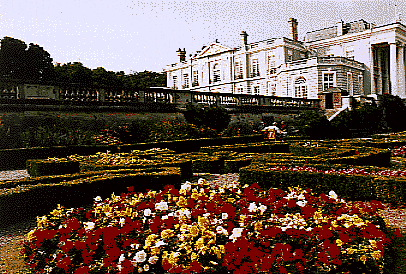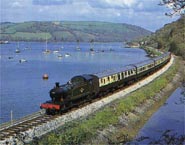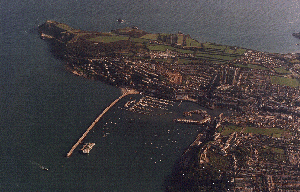
in the breeze!
© Frances J Foot, 1999 :)
TORBAY |

and this one! "Sunny Daze"!
Amazing, huh?!?!
© Frances J Foot, 1999
 in the breeze! © Frances J Foot, 1999 :) |
|
 and this one! "Sunny Daze"! © Frances J Foot, 1999 |
TORQUAY |
||
  |
Palm trees and a mild climate give Torquay a Mediterranean atmosphere. There are two popular, soft sand beaches and the town caters mainly for its holiday trade, therefore restaurants and amusement arcades abound. There is also a good shopping-centre and the possibility of rowing in the harbour and ruining one of the posh boats moored there, by rowing into it! There are some fine hotels. The harbour was first developed when the monks from Torre Abbey built a quay. The monastery is now incorporated into the abbey which also houses an art gallery. There is a magnificent barn in the grounds where prisoners captured from the Spanish Armada of 1588 were once held. The charming miniature town of Babbacombe Model Village lies slightly to the north - whilst also in the near vicinity are Kent's Cavern and Cockington (see photos below). And let us not forget, whatever we do, Torquay United Football Club! (Unofficial Site). This is an OK place by me though; met Benni Carbone here - and Florin Raducioiu and Marc Rieper and Slaven Bilic and Paulo Futre and Ilie Dumitrescu and . . . . .
|

|
COCKINGTON |
Cockington is a perfect Devon village, with a 14th century Old Forge, an Old Mill beside the village pond which sells cream teas. At Cockington Court, a Tudor manor house, artists and craftspeople, including workers in stained glass and woodcarving can be watched at work; also a blacksmith and a stonemason. In the summer months, there is village cricket on the green, and horsedrawn carriages run from Torquay. Cockington Country Park is next door. |
Some 250,000 years ago, primitive man occupied these caves. Now modern man can see their beauty by floodlight. Flint axes and tools found here, are now displayed in Torquay Museum. More pictures |
|
PAIGNTON |
 |
Paignton, just down the coast from Torquay, still on Torbay, is very different from Torquay - very much a typical English seaside resort. There are bathing huts, punch and judy shows, sand sculptures and an old pier. What I haven't mentioned before is that the soil is red in this region, therefore the sand is as well! (well, reddish - more red than white, shall we say - perhaps brown though!). 100-room Oldway Mansion (right) was built by sewing-machine tycoon Isaac Singer, which he partly modelled on Versailles. |
 |
 |
Paignton Zoological and botanical gardenscover 75 acres. (A nice setting; it's darned expensive to get in though!). |
The South Devon Railway keeps puffing engines and the steam age alive between Totnes and Buckfastleigh. Exotic butterflies and moths at Buckfast Butterfly and Otter Sanctuary |  |
BRIXHAM
|
Brixham is the 3rd of the recognised "Torbay" resorts, although much smaller than the other two. It is a still busy, ancient fishing port. The town's museum contains maritime mementos. The aquarium displays living examples of creatures for which local fishermen risked life and limb. A replica of Drake's ship the "Golden Hind" (left) is a floating museum (usually surrounded by photographers with monkeys!) Nearby is "the Deep", a marine theme park with bathysphere, mermaid's cave, and pirate ship. |
 |
|
The book says of Dawlish, "Regency and Victorian houses turn their backs on the sea to face Dawlish Water where black swans swim. North is Dawlish Warren, a 500 acre nature reserve.", but I know it a lot better than this, having spent many happy family holidays here (when I was much younger) and many return trips since. The swans, the ducks, the band in the park, the prom, the "99"s, the candy floss, the coves, the trains, the caravan park up the hill, the mushrooms in the field, the cesspit (!), cricket on the grass, the cool pub, "the Smugglers Inn" with delish ploughman's lunches. Can almost smell the ozone! A very nice place, filled with memories. |
Teignmouth, where small ships negotiate swift currents to reach the quay, is altogether different to Dawlish. Dartmoor granite was shipped from here to build old London Bridge in 1831. Victorian and Regency houses overlook the "very red" beach. |
|